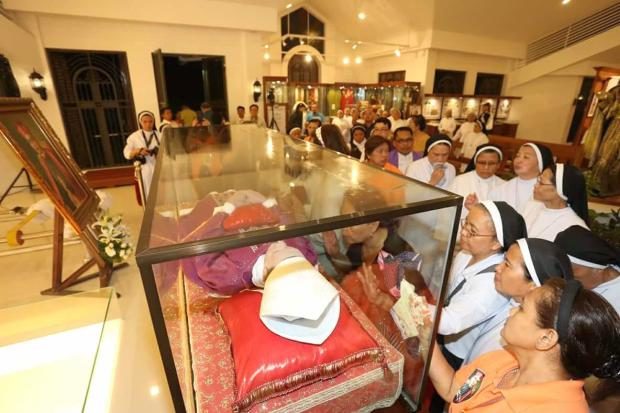
The skull and bones of the late Archbishop Teofilo Camomot were placed inside a wax figure of the well-loved prelate on Wednesday, Jan. 3, 2018. The wax figure was then displayed for public viewing at the Domus Teofilo (House of Teofilo) in Barangay Valladolid, Carcar City, (Photo by JUNJIE MENDOZA / Cebu Daily News)
CARCAR CITY, Cebu — The remains of Cebuano Archbishop Teofilo Camomot, a candidate for sainthood, was exhumed on Wednesday.
The skull and bones were then placed inside a wax figure of the well-loved prelate, which was displayed for public viewing at the Domus Teofilo (House of Teofilo) in Barangay Valladolid, Carcar City.
The remains of the prelate went through forensic examination for about nine hours by Manila-based experts led by Dr. Erwin Erfe.
Fr. Samson Silloriquez, the Rome-based postulator of the cause of sainthood of Camomot, said the body was already corrupted.
“But it doesn’t mean he is not a saint. Even if his body is corrupted, that is not a condition that he is not in heaven,” he explained.
Silloriquez said Camomot’s bones were preserved by the forensic experts for future purposes.
“They counted the bones and put them together,” he said.
“We also got some parts of the bones to be used as relics. But these could not be used since he has not been declared a saint at this stage,” he added.
Camomot’s remains are set to be placed on its new tomb after the 4 p.m. Mass to be presided by Cebu Archbishop Jose Palma on Thursday at Domus Teofilo, a museum that houses the personal belongings and writings of Camomot, according to Fr. Mhar Balili, the vice postulator.
Camomot’s body was first exhumed from the public cemetery in Carcar City in 2009 and was transferred to the compound of the Daughters of Saint Teresa (DST), a congregation that he founded.
Only Cebu Archbishop Jose Palma, some priests, the DST sisters, and relatives of Camomot were allowed to witness the examination of the late archbishop’s body.
Public viewing of Camomot’s remains started at 7 p.m. on Wednesday.
In November 2017, the Vatican’s Congregation for the Causes of Saints approved the diocesan process for the cause of sainthood of Camomot, who was known for his extreme generosity and love for the poor.
The diocesan process includes gathering of documents and writings of Camomot as well as the testimonies of witnesses who had personal encounters with the archbishop.
The next part would be the preparation of the Positio, which would summarize the life and virtues of Camomot. Balili said the Positio includes the biography of Camomot, the testimonies of witnesses, and explanation why the late archbishop should be declared a saint of the Catholic Church.
When the Positio is finished, it will be submitted to the Congregation for the Causes of Saints in Rome.
It will be studied by theologians and then passed to the cardinal members of the congregation who in turn will vote.
Their votes will determines whether the cause will continue or end. I
f the vote is affirmative, the recommendation of a Decree of Heroic Virtues is sent to the Pope.
Once the candidate’s heroic virtues have been recognized by the Pope, Camomot will be called “venerable.”
“From there, we wait for one miracle so that he will become a blessed. And once he become a blessed, we will wait for another miracle to become a saint,” Balili explained.
Camomot, fondly known as Monsignor Lolong, was known for his exceptional love for the poor. In once instance, the Carcar City native pawned his episcopal ring and pectoral cross (the large crucifix worn by bishops) and gave the proceeds to the poor.
The archbishop would also give away whatever he had to the needy.
Camomot died in a vehicular accident in San Fernando town on Sept. 27, 1988. He was 74.
The Archdiocese of Cebu ruled that the heroic virtues demonstrated by Archbishop Camomot were worthy of sainthood. /atm